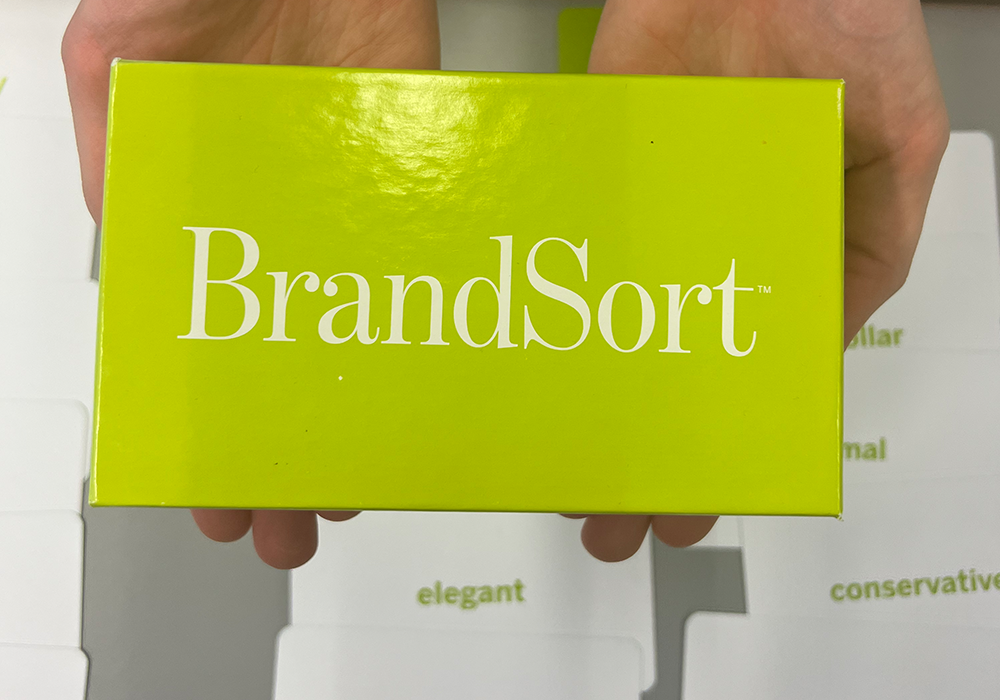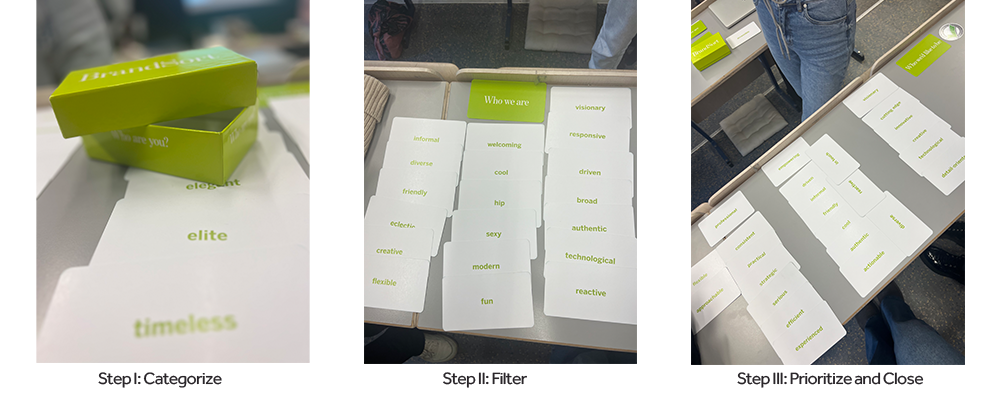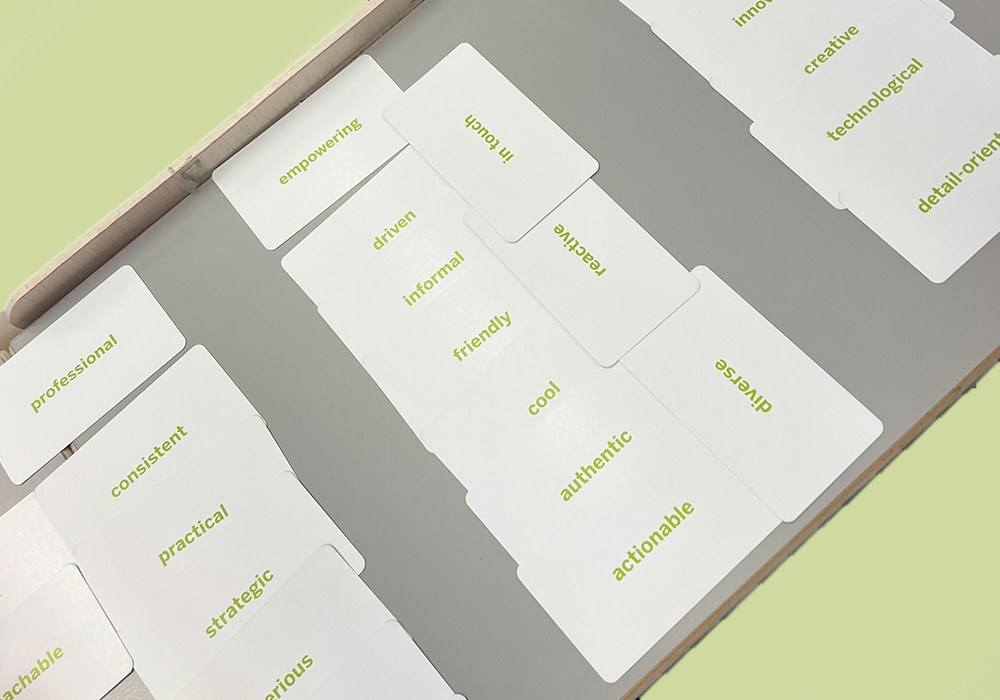Towards the end of the 90s, user orientation became an important motto in web development and web design (although not necessarily in the practice of companies). User orientation is often proclaimed as the most crucial guideline in content strategy. But if an organization is communicating only to meet user needs, its business value may become unrecognizable and the brand generic. The course “Brand Values & Message Architecture” focuses on the role and the requirements of brands and on ways to solve brand-related challenges through content strategy. This lecture describes the procedure for implementing such a strategy at an introductory level.
The lecturer Margot Bloomstein is a passionate content strategist with more than 20 years of experience in the field. Brand-driven content strategy is the lens through which she looks at our discipline. “It is not the only one, but it is one right way,” Bloomstein explains.
Margot Bloomstein provides different approaches to introducing the topic to class students. ‘Hands-on’ and ‘speak up’ is the overriding principle in each of her lectures.
Margot Bloomstein conceives developing a brand-driven content strategy as a three step process:
- the elaboration of a message architecture
- a brand-oriented content audit
- the definition of the most appropriate content types
Step 1: Message architecture: Translating values into actionable communication goals #
The message architecture is the organizing principle of a brand-oriented content strategy. By precisely carving out a message architecture, an organization can define actionable communication objectives based on what is most important to it. A message architecture does not consist of the brand's values themselves. It is a guide for external communication. It sets the direction of how an organization should communicate with its audience to get its message across. Since all businesses and organizations are dealing with constraints such as limited time or budget, the message architecture represents the most important communication goals in a prioritized order.
A message architecture is a hierarchy of communication goals; as a hierarchy, they're attributes that appear in order of priority, typically in an outline.
As an example, Margot Bloomstein showed the message architecture of a medical laboratory:
- Passionate about strategic discovery
creative, spirited, inspired
visionary, innovative thought leader, and industry leader
flexible
- Tactical and hands-on
in the trenches, in touch
detail-oriented and methodical
- Pioneering
groundbreaking, trend-setting
modern and savvy
- People-focused and market-driven
trusted by medical professionals, researchers, and media
industry news source
Message architecture in practice
Margot Bloomstein showcased many real-life cases of how message architecture works in practice. One striking example: She sparked up a discussion by asking which of these drinks contain the most caffeine:

None of the students in the class would have guessed the correct answer: Starbucks coffee. Why? Bloomstein explains that the messaging shapes the character of a brand and how it is being perceived. While Starbucks speaks more to professionals in suits, Red Bull focuses on the athletic consumer. The latter makes you believe that the drink gives you more energy, although that is in fact not true.
How to define a message architecture: card sorting exercise
Margot Bloomstein's preferred tool for developing a message architecture is a sorting exercise with a stack of brand cards. The stack consists of cards with around 100 possible brand attributes. Each attribute is printed on one card. The participants assign the cards to 3 different columns:
Who we are not
Who we are
Who we’d like to be

How to conduct a qualitative content audit #
The participants are free to add brand attributes that they miss. When all cards have been assigned to one of the columns, the pile of cards in the who-we-are-not-column gets tossed away. In a second round, the participants try to discover the three most important attributes of their organization together with some accompanying or specifying secondary characteristics. They have to decide what values (attributes) they want to leave behind – in most cases, a difficult decision. But it is crucial to arrive at a small number of specific messages – otherwise, it is impossible to use the messages for deciding what to communicate and what not. Otherwise, the identity of the organization would not be sufficiently defined.
All attributes that the participants want to keep going into the pile of who we’d like to be. In the last step, the participants have to group similar attributes in word clouds and prioritize the attributes within each cloud. The result is a hierarchy of attributes representing an organization's communication goals.
How to conduct a qualitative content audit

Remark: Card sorting is also used in information architecture, e.g., to define navigation menus for a website.
The physical interaction with the cards makes the meaning of the selected terms perceptible to the senses. The shared space encourages a conversation around topics and concepts. During the whole process, the content strategist sticks to the role of a consultant and facilitator. She/he steps back to show the group members that it is their task and responsibility to decide on the messages. In the end, the deliverables can be entirely attributed to the client.
Margot Bloomstein's company Appropriate, Inc. distributes the BrandSort card set that Margot Bloomstein uses in her own work.
Step 2: Does your content fit to your message architecture? #
The message architecture is also the foundation for a qualitative content audit. What content do we already have, and is it any good? Does it align with the message architecture and the communication goals?
You can rarely start a content strategy from scratch. That is why content strategists must very carefully capture what is already there when they will lead a company on the rocky road of developing a strategy – before even writing the first word of copy or producing and curating illustrations.
A qualitative content audit has proven its worth here. To determine what should be continued, superfluous, and missing, the content strategist surveys the current status of an organization's content and evaluates its consistency with the message architecture. Margot Bloomstein underlines that there are different ways to audit the content. But in each of them, a specific motivation should guide the content strategist. A goal, a particular question, the message architecture – many things can be a reason to evaluate the content, but it does not make sense to perform an audit 'just because.'
Remark: You will find more information about content audits in the posts related to the COS course on content audits.
Quantitative, then qualitative content audit
Initially, it is necessary to determine the scope of the content to which the audit refers. This can be done with a quantitative audit. For a website content audit, a list of all the URLs can be put in a large spreadsheet (there are tools to do that). Next, the share of the different content formats should be evaluated. Are there a lot of PDFs on the web page? Are there many images (which is good)? Videos? Where are links set, or is there duplicate content? Are there dead links?
After this rough overview, the quality of the content can be determined. There are several ways to do this. The spreadsheet that has been created for the quantitative overview can be used as a base for evaluating the content piece by piece regarding the message architecture. An alternative procedure consists of following a customer journey through the existing website and checking if the customers' needs are met, or their questions are answered.
While the headcount of a quantitative audit can determine what's there, only a qualitative assessment can help you determine how good it is, whether you need to update it, and in what ways.
Doing the content audit also means dealing with constraints. In most cases, the restricted resources will only allow examining some of the available content. If it is only possible to analyze a strategically important website sample, it is crucial to define the criteria for its choice correctly.
A content audit is one of the key deliveries to the client. It is essential for defining the key elements of a content strategy. Without a qualitative audit, all subsequent recommendations for content will dangle in the air.
How to recommend appropriate content types
After conducting the audit, the content strategist should recommend content types and channels that fit the client's needs. The selected content types represent the communication goals of the business, organization, or company.
Examples show how closely connected channels, content types, and communication goals are: If the communication goal is to be perceived as engaging and fun, is an annual report the right channel? Or are a blog, games, and videos more appropriate? In other words, the chosen content types and channels will manifest the communication goals that have been defined in the message architecture.
Step 3: Appropriate content types: Finding the appropriate channels for your messages #
Based on the content audit it is possible to recommend appropriate content types.
What is a content type?
In his online glossary for web content management (Barker n.d.) Deane Barker defines a content type as follows: “The specification of a logical type of content–for example, a News Article or a Blog Post.” A content type can be seen as a generic description of the properties of a group of content items that define requirements and possibilities. Content types belong to channels: A blog post can belong to the channel website or LinkedIn, a how-to video can be part of a company's YouTube channel. Many business owners, CEOs, or even marketers are tempted to think it is sufficient to specify appropriate content, e.g., video. But only for a video of a specific type in a particular channel can you say whether it will suit the message and achieve its purpose. It is crucial to select content types that support the message architecture.
How to recommend appropriate content types
After conducting the audit, the content strategist should recommend content types and channels that fit the client's needs. The selected content types represent the communication goals of the business, organization, or company.
Examples show how closely connected channels, content types, and communication goals are: If the communication goal is to be perceived as engaging and fun, is an annual report the right channel? Or are a blog, games, and videos more appropriate? In other words, the chosen content types and channels will manifest the communication goals that have been defined in the message architecture.
Practical Experience: Content Audit for IKEA
One of the assignments the students had within the lectures was to conduct a content audit for a website of an assigned company or an organization. After the process was finished and the content has been analyzed, some recommendations have been provided.
Based on these outcomes, the next task was to pitch the chosen client with one content type the students considered useful or helpful for the company’s web presence.
Some of the examples included user-generated content for IKEA featuring inspiration photos or videos, tips and tricks or even “IKEA hacks”; an interactive event calendar for Vienna Tourism’s website, webinars for Berenberg Bank or product descriptions for Hofer’s online store.
The goal was to find a content type that would fit the company’s communication goals and explain how it could fit in and what would be the expected impact on the publishing culture of the company.
Where to go from here #
In her first book, Content Strategy at Work (2012), Margot Bloomstein described how she practices brand-oriented content strategy based on many examples. She has also presented her concept in many presentations (e.g., Brand-driven Content Strategy: Developing a Message Architecture 2016) and videos (e.g., Promoting Your Brand 2014). Since then, she has further developed her concept and published the book Trustworthy: how the most innovative brands beat cynicism and bridge the trust gap (2021).
COS students have written about Margot's teaching in blog posts and portfolios. One of them: Brand-driven Content Strategy (Knall 2021).
Our instructor Doris Eichmeier explores the relationships between brand communication and content strategy in the German-language content strategy community. In the book Die Content-Revolution in Unternehmen (Eck & Eichmeier 2014), she presents a method for brand-focused content audits which she has developed.
Some examples of brand-oriented content strategies development can be found by browsing through the COS-Master's Theses.
The COS program includes a separate course on content audits, which also discusses in detail other perspectives on audits and how they are handled technically. Content types are a subject of the introduction of the course to content management and content models.
References #
Barker, D. (n.d.). (2021, January 27). The Web Content Management Glossary [Book Companion]. Web Content Management; Blend Interactive. https://flyingsquirrelbook.com/glossary/
Bloomstein, M. (2012). Content strategy at work: Real-world stories to strengthen every interactive project. Morgan Kaufmann.
Bloomstein, M. (2016, September 19). Brand-driven Content Strategy: Developing a Message Architecture [Slideshow]. http://de.slideshare.net/mbloomstein/branddriven-content-strategy-developing-a-message-architecture-workshop-at-confab-intensive-2016
Bloomstein, M. (2021). Trustworthy: How the smartest brands beat cynicism and bridge the trust gap. Page Two Books.
Eck, K., & Eichmeier, D. (2014). Die Content-Revolution im Unternehmen: Neue Perspektiven durch Content-Marketing und -Strategie (1. Auflage). Haufe-Lexware GmbH & Co. KG.
Ellering, N. (n.d.). (2021, December 22). 113 Types of Content Marketing You Can Add to Your Calendar Now. CoSchedule. https://coschedule.com/content-marketing/types-of-content
Knall, A. (2021, January 15). Brand-driven Content Strategy. Antonia Knall. https://antonia.cc/brand-driven-content-strategy/
Margot Bloomstein | Promoting Your Brand / Day 2. (2014, October 9). https://vimeo.com/108578843
This article is a student-written report on a part of the course Brand driven content strategy in the 1st semester of the M.A. program in content strategy.
It reflects the understanding of the content from the students' point of view and may therefore contain interpretations that do not coincide with the instructor's opinions.

